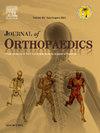Manual vs robotic patellofemoral arthroplasty outcomes: A Michigan arthroplasty registry collaborative quality initiative-based study
IF 1.5
Q3 ORTHOPEDICS
引用次数: 0
Abstract
Background
Historically, all patellofemoral arthroplasty (PFA) was performed manually. Recently, robotic-assisted PFA has gained popularity. The purpose of this study was to determine whether a robotic-assisted technique influenced outcomes and revision rates. We hypothesized that robotic-assisted PFA would have improved 90-day complication and revision rates.
Methods
A single center's data from the Michigan Arthroplasty Registry Collaborative Quality Initiative (MARCQI) was queried for all primary PFAs from January 2014 to December 2022. Manual and robotic cohorts were compared for revisions and 90-day complications, including emergency visits, readmissions, and returns to the operating room (OR). Chi-square and Fisher's exact tests were used for categorical data and t-tests for continuous data.
Results
Among 75 PFAs (mean age 53.0 ± 12.9 years, 78% women), 19 were manual and 56 robotic. Manual PFA experienced more 90-day complications (31% vs 10%, p = 0.0321) and a longer mean length of stay (30.9 ± 14.4 vs 20.6 ± 17.7 h, p = 0.03). No significant differences existed in age, BMI, gender, race, surgical time, 30-day complications, or revision rate. Manual PFA had no revisions, while 5% of robotic PFAs were revised for osteoarthritis progression, with a mean conversion time of 4.5 ± 2.7 years. Five-year cumulative percent revision (CPR) for all PFAs was 7.37%. Logistical regression showed manual PFA patients were more likely to experience 90-day complications (OR 3.84, p = 0.04).
Conclusions
Manual PFA were prone to more 90-day complications and longer hospital stays compared to robotic PFA, which may minimize complications without affecting revision rates. Importantly, the PFA revision rate herein exceeded MARCQI-reported rates for unicompartmental and total knee arthroplasty.
人工与机器人髌股关节成形术的结果:一项基于密歇根关节成形术注册中心协作质量倡议的研究
历史上,所有髌骨股骨置换术(PFA)都是手工进行的。最近,机器人辅助PFA越来越受欢迎。本研究的目的是确定机器人辅助技术是否影响预后和翻修率。我们假设机器人辅助PFA可以改善90天的并发症和翻修率。方法对2014年1月至2022年12月期间所有原发性PFAs的单中心数据进行查询,这些数据来自密歇根关节置换术登记处协同质量倡议(MARCQI)。比较人工和机器人队列的修改和90天并发症,包括急诊、再入院和返回手术室(OR)。分类数据采用卡方检验和Fisher精确检验,连续数据采用t检验。结果75例PFAs(平均年龄53.0±12.9岁,78%为女性)中,手动PFAs 19例,机器人PFAs 56例。手工PFA的90天并发症较多(31% vs 10%, p = 0.0321),平均住院时间较长(30.9±14.4 h vs 20.6±17.7 h, p = 0.03)。年龄、BMI、性别、种族、手术时间、30天并发症或翻修率无显著差异。手动PFA没有进行修正,而5%的机器人PFA因骨关节炎进展而进行了修正,平均转换时间为4.5±2.7年。所有PFAs的五年累积百分比修正(CPR)为7.37%。逻辑回归显示手工PFA患者更容易出现90天并发症(OR 3.84, p = 0.04)。结论与机器人PFA相比,手动PFA容易出现更多的90天并发症和更长的住院时间,可以在不影响翻修率的情况下减少并发症。重要的是,本文的PFA翻修率超过了marcqi报道的单室和全膝关节置换术的翻修率。
本文章由计算机程序翻译,如有差异,请以英文原文为准。
求助全文
约1分钟内获得全文
求助全文
来源期刊

Journal of orthopaedics
ORTHOPEDICS-
CiteScore
3.50
自引率
6.70%
发文量
202
审稿时长
56 days
期刊介绍:
Journal of Orthopaedics aims to be a leading journal in orthopaedics and contribute towards the improvement of quality of orthopedic health care. The journal publishes original research work and review articles related to different aspects of orthopaedics including Arthroplasty, Arthroscopy, Sports Medicine, Trauma, Spine and Spinal deformities, Pediatric orthopaedics, limb reconstruction procedures, hand surgery, and orthopaedic oncology. It also publishes articles on continuing education, health-related information, case reports and letters to the editor. It is requested to note that the journal has an international readership and all submissions should be aimed at specifying something about the setting in which the work was conducted. Authors must also provide any specific reasons for the research and also provide an elaborate description of the results.
 求助内容:
求助内容: 应助结果提醒方式:
应助结果提醒方式:


